Throughout my life I’ve always seen a balance with everything. Too much of one thing is not ideal, but not having enough is not ideal either. I was looking for papers to blog about fish sustainability in our oceans, and I found an article that stated right in the abstract that there are two sides to the issue. One side sees universal failure in fisheries management and wants to use protected marine sanctuaries as the ultimate tool to try to rebuild the state of the marine ecosystems around world. This has been done in various locations around the united states with many positive results.
On the other side of the issue are people who are working in fish industries who realize that there have been numerous failures in the management of ocean fishing. But there have also been success stories, and instead of simply making sanctuaries, “This group argues that we need to apply the lessons from the successful fisheries to stop the decline and rebuild those fisheries threatened by excess fishing.â€
Worm et al. stated that if fish stocks keep declining in the same rate as they are now that the world fish stocks will collapse by 2048. With collapsed stocks, diversity of an ecosystem shatters. Worm et al. proposed that the health of a habitat is directly reliant on the diversity that it holds. They set up 32 controlled experiments as well as 12 estuarine experiments to examine the effects of variation of marine diversity of fauna and flora, resource use, and nutrient cycling. They found that increased diversity enhanced all ecosystem processes.
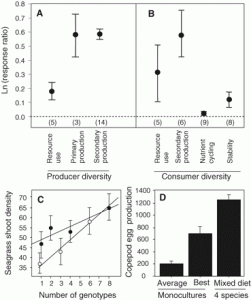
Worm et al. The graphs of Marine biodiversity and ecosystem functioning in controlled experiments.
He found that the more diversity an environment contained, the more capable it was to withstand stress; a factor quite important in these environmentally stressful times.
A proposed explanation was given to explain the advanced recovery at high diverstiy: fishers can switch more readily among target species, and therefore providing overfished species a chance to recover. By restoring biodiversity in the marine habitats through sustainable fisheries, pollution control, and the creation of marine reserves (as stated above), we can reliably invest in what our oceans provide us.
Annoyingly so, I love seafood. When you become a marine biology major, you realize how far we are away from having sustainable fisheries, and it can be quite disgruntling to discover that what you love to eat is not a sustainable food source. But now I carry a seafood watch card in my purse that was released through the Monterey Bay Aquarium.
Here at the Friday Harbor Labs we’ve had some fish for dinner here and there. Most of the selection is Tilapia, and most tilapia comes from fish farms, which is debatably sustainable. Yesterday I was surprised that King Salmon was put on the menu as our main entrée here at the labs. King salmon, also known as Chinook salmon, is considered to be a threatened species in the Puget Sound area. I thought that it was so ironic that a marine science laboratory would have that particular fish on the menu here. Although it’s endangered and threatened in many areas along the Pacific Coast, there are some sustainable practices of Chinook in certain areas, such as wild caught Alaskan salmon. Chinook salmon also happens to be the orca’s favorite type of salmon to eat.
This being said, it is vital for our endangered southern resident killer whales that we do the above suggestions: create marine sanctuaries and create regulations of fishing to maintain diversity and the ecosystem’s ability to handle stress from a rapidly altering environment. There has always been a sense of “freedom of the sea†and the idea of regulations on fish stocks is relatively new. But due to our intense fishing practices, regulations must be installed if we or other creatures depending on fish such as killer whales want to able to fish in the future, especially for the threatened King salmon.
Read More
Fish hatcheries have become ever more important in recent years due to the declines in wild stocks. The aim of hatcheries is to replenish the wild stock in order to keep the fishing industry sustainable, but there is still debate as to what is the best approach to this without causing further damage to the wild population. In an attempt to make improvements to hatchery practices, Hitoshi Araki studied the reproductive success of hatchery trout compared to wild trout, and made suggestions in his paper Hatchery Stocking for Restoring Wild Populations: A Genetic Evaluation of the reproductive Success of Hatchery Fish vs. Wild Fish (2008).
The hypothesis was that fish bred using the traditional hatchery methods, in which the fish are usually non-local and are bred for many generations in captivity, have much lower reproductive success than both supplemental hatchery fish and wild fish. The idea behind supplemental hatchery methods is to use local parent fish to breed “wild stock” hatchery fish in a protected environment, and then release them into the wild population, with the overall goal being to re-create a sustainable wild population. Using DNA analysis of steelhead trout from the Hood River, Araki determined the reproductive success of traditional hatchery fish, supplemental hatchery fish, and wild fish. He found that the more generations bred in a hatchery, the less reproductively successful the fish are.
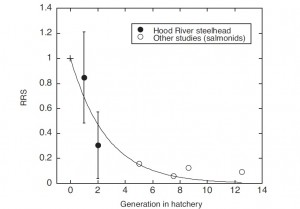
Picture 1: Araki used his own data and data from previous studies to show the decline in relative reproductive success (RRS) as the number of generations in a hatchery increased.
Araki also found that supplemental hatchery fish had significantly higher reproductive success than the traditional hatchery fish, though they still had lower reproductive success than the wild population. When a wild stock parent was crossed with a traditional hatchery parent the reproductive success dropped. This shows the effect that hatchery fish can have on the wild population. If traditional hatchery fish continue to be released into wild populations in attempt to sustain them, they will continue to lower the reproductive success of the wild population.
It seems that, though hatcheries have a positive sustainability goal in mind, the traditional methods they are using to replenish wild stocks are somewhat counter-acting what they are trying to achieve. Though it may be more work to implement supplemental hatchery methods, the benefit of higher reproductive success of the population should be worth it.
Araki used steelhead trout as his example organism, but it is assumed that similar principles could apply to other fish species. In the San Juan and Vancouver Island area, salmon hatcheries are an important part of the fishing industry (and produce important food for the Southern resident orcas!). Since Chinook salmon are endangered in the area, a large amount of juveniles are released into the wild from hatcheries. From the information I could find, it seemed hatcheries in the area are attempting to use methods closer to supplemental techniques rather than the traditional methods. For example, the San Juan Enhancement Society in Port Renfrew, BC collect their broodstock (parent fish) of Chinook from a lake connecting to the San Juan River, therefore the juvenile fish are being released into their natural habitat. Though it isn’t stated how many generations are produced in the hatchery, it still could be considered a step in the right direction compared to using a non-local broodstock. Hopefully in the future hatcheries move towards supplemental practices so that the wild stocks, the ecosystem, and everyone utilising the fish can further benefit from sustainable fish populations.
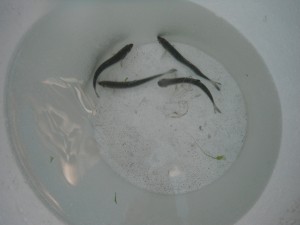 Picture 2: Both wild and hatchery juvenile Chinook can be found in the San Juan Islands, as our Beam Reach class found out while beach seining on Lopez Island. The hatchery salmon had their fins clipped for identification.
Picture 2: Both wild and hatchery juvenile Chinook can be found in the San Juan Islands, as our Beam Reach class found out while beach seining on Lopez Island. The hatchery salmon had their fins clipped for identification.
Read More
Isn’t it great having it warmer longer and being able to soak up the sun longer once summer is over?! Maybe you know the reasons from various classes or the news. Besides hearing how high CO2 levels are do you actually know how CO2 levels are affecting organisms physically? CO2 is like a fish drug that is affecting their olfactory systems and desensitizing fish to instinctive behaviors.
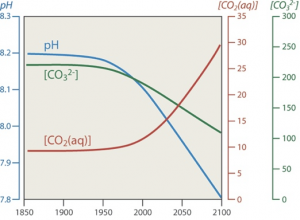 A brief background – Ocean inhabitants, especially coral reef inhabitants, are sensitive to changes whether it is temperature, CO2 concentrations, or pH. If CO2 levels continue to increase as they are, by the end of the century, there would be about 1,020ppm of atmospheric CO2 (more than enough to dramatically affect multiple marine organisms). Atmospheric and dissolved CO2 levels are linearly correlated. If atmospheric CO2 increases, dissolved CO2 in the ocean increases simultaneously. CO2 and pH levels are indirectly correlated. If dissolved CO2 increases, pH decreases. If maintaining down the current path, oceanic pH would decline up to 0.4 units, making the ocean even more acidic.
A brief background – Ocean inhabitants, especially coral reef inhabitants, are sensitive to changes whether it is temperature, CO2 concentrations, or pH. If CO2 levels continue to increase as they are, by the end of the century, there would be about 1,020ppm of atmospheric CO2 (more than enough to dramatically affect multiple marine organisms). Atmospheric and dissolved CO2 levels are linearly correlated. If atmospheric CO2 increases, dissolved CO2 in the ocean increases simultaneously. CO2 and pH levels are indirectly correlated. If dissolved CO2 increases, pH decreases. If maintaining down the current path, oceanic pH would decline up to 0.4 units, making the ocean even more acidic.
Munday et al. conducted a study to see the effects CO2 levels have on fish populations. This study was looking at clownfish and damsel fish larvae and how they respond to three different levels of CO2. The control was current CO2 levels (390ppm), 550ppm, 700ppm, and 850ppm. Behavioral responses and olfactory cues from predators were noted and it was noticed how drastic the effects of CO2 levels really were. With each increasing dosage the results were more significant. Natural and instinctive behaviors are thrown off due to the destructive influences CO2 has on the olfactory system. Instead of smelling predator cues and hiding, the increased CO2 levels cause clownfish and damsel fish to be less sensitized and alert. The fish participated in increasingly risky behavior such as spending more time where predator cues were present, swimming farther from the protections of the reef, and being more active but less alert to predator cues.
The longer a fish is exposed the worse the symptoms. Age also increased the severity of the symptoms. Noting the same change in behaviors another experiment was conducted with predator encounters. The more frequent, careless, and risky behaviors became the higher mortality rate climbed.
Not only do rising CO2 levels cause concern for species, but trying to sustain the species at risk becomes more complex. Protecting an ecosystem may no longer be enough if fish are being easily preyed upon due to the severe behavioral effects of increasing CO2 levels. Assuming other marine species will exhibit similar responses, the effects of rising CO2 on biodiversity of marine ecosystems could be significant and the effects irreversible.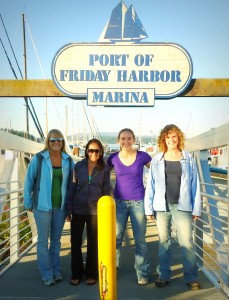
Chinook salmon are already endangered and, if the hypothesis is correct, the increasing dissolved CO2 levels could be an additional threat. Chinook, being the Southern Residents primary food source, may have a crucial impact on the killer whales if they cannot handle the added stress from rising CO2 levels. Will the Southern Residents adapt to the CO2 levels or will they suffer as much as the Chinook and other marine organisms?
The 4 students in the Fall 2011 session, along with past and future students, will study the environment and see how different factors affect the killer whales. Students are looking at relationships between the whales and salmon, human influences, and natural influences. We all start our first expedition Sunday (18th) to start collecting data for our final projects. Watch for our final projects as time moves forward!
Read More
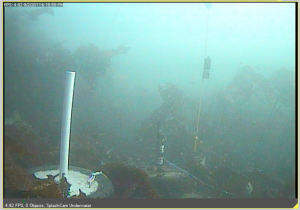
CPOD stand, hydrophones, and Vemco receiver
In collaboration with The Whale Museum, including Research Curator Stefan Bräger and Board member Jason Wood, the fall Beam Reach class has been studying fish and porpoises from the Lime Kiln State Park lighthouse. We’ll be posting results as they accrue, but for now this screengrab shows new instruments from the perspective of the Beam Reach underwater video “Splashcam.” On the left is a stand for 3 CPOD porpoise click detectors (now deployed) provided by Jim Thomson of UW/APL; in the middle are cleaned up hydrophones; on the right is a Vemco fish tag receiver deployed as part of a project led by UW’s Tom Quinn and NOAA’s Kurt Fresh.
The fall class has been surveying the ocean near Lime Kiln for harbor and Dall’s porpoises, monitoring the underwater camera for fish, measuring water properties, and sampling the plankton.  Surprises have been seeing seals and salmon swim by underwater just outside the kelp adjacent to Lime Kiln Point.
Read More
Have you ever bought something that had a little gold sticker that said “Made in China”? I see that little sticker all over the place! Although it’s not necessarily China, but you get the idea. Of course, all this “Made in (insert country here)” stuff had to have gotten here somehow. We were asked to choose a case study in sustainability science, and the sustainability case study I chose was one about ballast water in ships (like the ships with China’s, or any other country’s, merchandise). Water gets pumped into these ships in order to stabilize it enough to make a safe journey across the oceans. After it gets pumped into ships, it’s then called “ballast water.” What people had often overlooked were the microorganisms residing in this water, such as phytoplankton, zooplankton, and small fish. These organisms get shipped hundreds of miles and get released into an entirely different ecosystem. Often these organisms die out on the journey, but every once and a while there comes a time when a nonlocal organism thrives in their new habitat. These organisms can explode in numbers uncontrollably and can sap the nutrients from the original organisms that reside there. Ballast water is like an ongoing moving infection caused by people in our oceans.
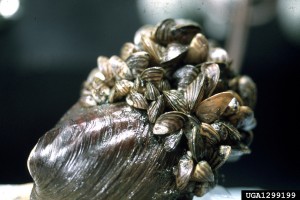
Zebra Mussel
This affects oceans everywhere. Right here in the San Juan Islands there is a bivalve invertebrate Nuttallia obscurata, also known as the purple varnish clam, that came to us through ballast water in the 1980s. The population here varies from quite rare to having up to 700 organisms per square meter. This is not just confined to our oceans; these organisms can spread to our lakes as well. Being from Minnesota, I know about the invasion of zebra mussels. They were believed to have been introduced to the St. Lawrence River in the late 1980’s. These little critters require $500,000,000 per year to control their catastrophic numbers in the Great Lakes alone. They smother local creatures, damage harbors, and need to be cleared regularly from waterways and water treatment plants.
There are different ways to go about this problem. Some have proposed sanitation standards for ballast discharge, which annihilates organisms living in the water. I asked my fellow colleagues in my Beam Reach class how they would go about this problem. Someone suggested that the ballast simply remain in the ship until it returned to its original body of water. Someone else suggested that the ballast should be dumped in the open ocean instead of the harbors. I was very happy with these comments, because they’re thinking right along the lines of John M. Drake, David M. Lodge, and Mark Lewis. They proposed diluting the release of non-indigenous species by limiting the volume of ballast water in a certain location. Spreading organisms reduces the chance of invading sexually reproducing species to flourish and expand. They also argued that the larger an organism is in a species, fewer individuals are required for an invasive blooming population, and simply a filter installed in the ballast release chambers could lower risks of bombardment. They used a reaction-diffusion model and allometric scaling to estimate a safe volume of ballast water that can be released for the smallest maximum for the types of organisms being pumped into the ships.
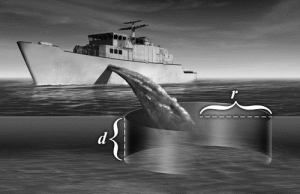 The idea is to create a population of sexually reproducing organisms that is small enough to diffuse until extinction in the area.
The idea is to create a population of sexually reproducing organisms that is small enough to diffuse until extinction in the area.
There is still a great deal of uncertainties that come with this method. Much diffusivity for certain species (or how few organisms is required for the invading species to successfully diffuse) is unknown, and would have to be researched. This method also runs under the assumption that the organisms all sexually reproduce. Dispersal is still very possible over long distances, depending on the species. There is also the foreseen problem that even if a ship were to dump the designated “safe†amount of ballast, precaution would have to be made to make sure that multiple ships weren’t releasing ballast water in the same areas.
The whole idea is to make sure that transported invasive organisms are lost to the population through diffusion faster than they can reproduce. I believe that this offers a simple alternative, and at least a start, to the incredibly impacting problem of fresh and marine habitats. I dislike how their solution doesn’t pertain to non-sexually reproducing fauna and flora, but I appreciate how realistic this temporary solution could be.
So when you buy your “Made in (insert country here)” socks, know that it’s at the cost of marine ecosystems worldwide.
Read More
A continuation of the study started in 1967 on Lake Ontario was carried out in the Great Lakes (Superior, Huron, Erie, Ontario, and Michigan) to determine the species and abundance of crustaceans and zooplankton during the summer months. Summer was chosen because it is the period when all of the Great Lakes reach maximum temperature and production. This
study focuses on the relationship between temperature and lake eutrophication. Eutrophication occurs when nitrogen and phosphorous levels are increased. The increase in nitrogen and phosphorous levels accelerates the growth of algae and
plants which deplete both oxygen levels and biodiversity.  A general trend was seen in oligotrophic (water poor in dissolved nutrients and rich in dissolved oxygen) Lake Superior to eutrophic Lake Erie. The trend occurring is a significant decrease
of Calanoids and an increased predominance of cyclopoids and cladocerans. This trend raises significant concerns because
calanoids take in energy from phytoplankton and algae, and repackage it for food consumption, making it an intricate part of the food web. In addition to the depletion of calanoids, an increase of cyclopoids and cladocerans (small crustaceans, or fresh water fleas) causes great concern as well. While the Great Lakes show different degrees of progressing eutrophication, previous
limnological studies show a number of pronounced changes in the chemistry and biology in some of these lakes over the past 60 years.
According to Patalas, K., the most significant factor determining the degree of eutrophication is due to human populations inhabiting the basin. While the increased number of species common to all the Great Lakes may be the result of a similar postglacial history of the lakes, this study concludes that differences in total abundance of certain species could be a reflection of the present morphological differences in chemical conditions. It further concludes that human influences on chemical conditions have a greater effect on eutrophication than physical conditions, such as temperature. The phosphorous loading in these lakes
affects nutrient loading. It was determined that removing phosphorous from detergents would decrease the total phosphorous loading by 0.5g/m2. Approximately 60% of phosphorous loads come from the detergents that humans use, and a drastic reduction of phosphorous is necessary to expect some apparent changes in the clarity of the water.
While it may seem that lake eutrophication is only a problem for the ecosystem of a particular lake that is being affected, this is
untrue. Not only does the crash of one ecosystem destroy the life that it once sustained, but it has devastating effects on surrounding, and interconnected ecosystems alike. Because the great lakes form a chain connecting them to the St. Lawrence River which leads to the Atlantic Ocean, the decline of species like calanoids in these lakes has an adverse effect on many animals including baleen whales, bowhead whales, right whales, and fin whales which consume them. It is important to remember that
every environment plays a unique and important role in the intricate and delicate web of life; which is why it is crucial to protect and maintain all natural environments.
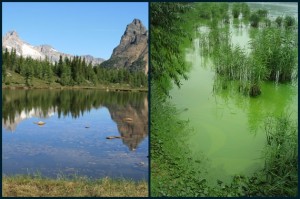
This picture compares a nice clean lake (left), to one which is highly eutrophic (right). I think you get the picture!
Read More












 Twitter
Twitter LinkedIn
LinkedIn Facebook
Facebook